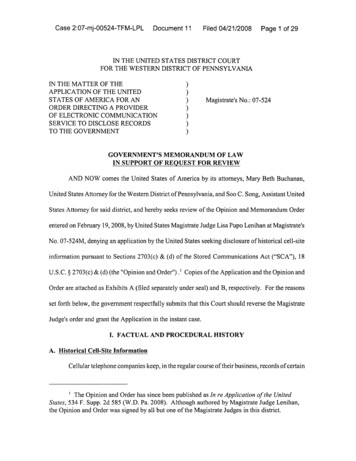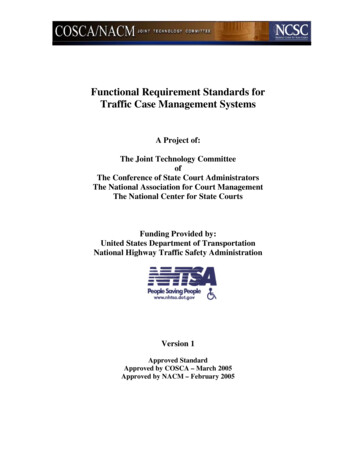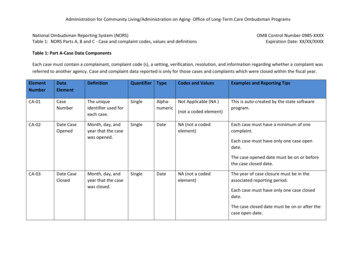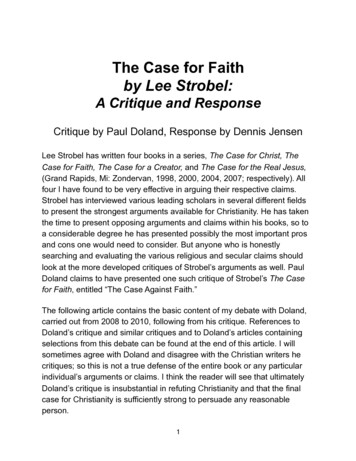
Transcription
Case 2:07-mj-00524-TFM-LPLDocument 11Filed 04/21/2008Page 1 of 2 9IN THE UNITED STATES DISTRICT COURTFOR THE WESTERN DISTRICT OF PENNSYLVANIAIN THE MATTER OF THEAPPLICATION OF THE UNITEDSTATES OF AMERICA FOR ANORDER DIRECTING A PROVIDEROF ELECTRONIC COMMUNICATIONSERVICE TO DISCLOSE RECORDSTO THE GOVERNMENT)11Magistrate's No.: 07-524)111GOVERNMENT'S MEMORANDUM OF LAWIN SUPPORT OF REQUEST FOR REVIEWAND NOW comes the United States of America by its attorneys, Mary Beth Buchanan,United States Attorney for the Western District of Pennsylvania, and Soo C. Song, Assistant UnitedStates Attorney for said district, and hereby seeks review of the Opinion and Memorandum Orderentered on February 19,2008, by United States Magistrate Judge Lisa Pupo Lenihan at Magistrate'sNo. 07-524M, denying an application by the United States seeking disclosure of historical cell-siteinformation pursuant to Sections 2703(c) & (d) of the Stored Communications Act ("SCA"), 18U.S.C. 4 2703(c) & (d) (the "Opinion and Order") .' Copies of the Application and the Opinion andOrder are attached as Exhibits A (filed separately under seal) and B, respectively. For the reasonsset forth below, the government respectfully submits that this Court should reverse the MagistrateJudge's order and grant the Application in the instant case.I. FACTUAL AND PROCEDURAL HISTORYA. Historical Cell-Site InformationCellular telephone companies keep, in the regular course of their business, records of certain' The Opinion and Order has since been published as In re Application of the UnitedStates, 534 F. Supp. 2d 585 (W.D. Pa. 2008). Although authored by Magistrate Judge Lenihan,the Opinion and Order was signed by all but one of the Magistrate Judges in this district.
Case 2:07-mj-00524-TFM-LPLDocument 11Filed 04/21/2008Page 3 of 29B. The United States' Application Pursuant to 18 U.S.C. 6 2703(d) in this InvestigationPursuant to 18 U.S.C. § 2703(c)(l), the United States may require a provider of electroniccommunication service to disclose "a record or other information pertaining to a subscriber to orcustomer of such service (not including the contents of communications)" when it obtains a courtorder for such disclosure pursuant to 18 U.S.C. 8 2703(d) (hereinafter, a "2703(d) order"). A2703(d) order is issued by a court when the government provides "specific and articulable factsshowing that there are reasonable grounds to believe that the contents of a wire or electroniccommunication, or the records or other information sought, are relevant and material to an ongoingcriminal investigation." 18 U.S.C.5 2703(d).On February 22,2008, the United States filed an application with Magistrate Judge Lenihanseeking a 2703(d) order directing Sprint Spectrum to disclose certain historical connection and cellsite information associated with a specified cell phone. See Exhibit A. The cell phone records arerelevant and material to an ongoing investigation into large-scale narcotics trafficking and variousrelated violent crimes.In June 2007, the Bureau of Alcohol, Tobacco, Firearms and Explosives ("ATF") learnedfrom a confidential source that a particular subject and his associates use their wireless telephonesto arrange meetings and transactions in furtherance of their drug trafficking activities. Additionalinvestigation, along with information from the source, indicates that the subject's narcotics supplierlives in another state. Because the subject and his confederates use a variety of vehicles andproperties to conduct their illegal activities, physical surveillance has proven difficult. In order todevelop better information on the location and identity of the drug supplier, the instant Applicationseeks historical cell-site records concerning a phone known to be used by the subject. Section
Case 2:07-mj-00524-TFM-LPLDocument 11Filed 04/21/2008Page 4 of 2 92703(d) orders are broadly used and widely accepted for these types of purposes in federal criminalinvestigations across the country.On February 19, the Magistrate Judge denied the Application, ruling in a written opinion thatthe United States is barred as a matter of law from obtaining historical cell-site information pursuantto a 2703(d) order.11. ISSUE PRESENTEDThe issue before the Court is purely a question of law, namely whether the government mayobtain historical cell-site usage records pursuant to an order under 18 U.S.C.4 2703(d).111. SUMMARY OF ARGUMENTSection 2703(d) permits the government to obtain acourt order compelling historical cell-siteusage information from a wireless carrier. The plain language of the statute unambiguously statesthat the government may require "a provider of electronic communication service" to disclose "arecord or other information pertaining to a subscriber" pursuant to a 2703(d) order. As explainedbelow, historical cell-site information satisfies each element of the statute, a position endorsed inrecent months by several other courts.In reaching the opposite conclusion, the Opinion and Order contains numerous errors, bothas to the facts of the underlying technology and as to the interpretation of applicable law. Indeed,as discussed below, we believe the Opinion and Order materially relies on at least one statute (andseveral cases) wholly inapplicable to the government's request for stored records of past customeractivity. In addition, because wireless carriers regularly generate and retain the records at issue, andbecause these records provide only a very general indication of a user's whereabouts at certain times
Case 2:07-mj-00524-TFM-LPLDocument 11Filed 04/21/2008Page 5 of 2 9in the past, the requested cell-site records do not implicate a Fourth Amendment privacy interest.Because the Opinion and Order misstates both the relevant facts and the applicable law, werespectfilly urge the Court to reverse.IV. ARGUMENTA.Historical Cell-Site Information Falls Within the Scope of Sections2703(c) and (d)As the Third Circuit has often reiterated, "'[tlhe plain language of the statute is the startingplace in our inquiry."' United States v. Introcaso, 506 F.3d 260,264 (3d Cir. 2007) (quotingstaplesv. United States, 5 11 U.S. 600,605 (1 994)). "'If the language of a statute is clear[,] the text of thestatute is the end of the matter."' Id. (quoting United States v. Jones, 471 F.3d 478, 480 (3d Cir.The Stored Communications Act (SCA), 18 U.S.C.552701 et seq., establishes acomprehensive framework regulating government access to customer records in the possession ofcommunication service providers. The statute's structure reflects a carefully crafted series ofCongressional judgments; it distinguishes not only between communications contents (5 2703(a),(b)) and non-content records (5 2703(c)), but also between different classes of non-content records.18 U.S.C.6 2703 unambiguously states that the government may require "a provider ofelectronic communication service" to disclose "a record or other information pertaining to asubscriber to or customer of such service (not including the contents of communications)" pursuantto a 2703(d) orders4See 18 U.S.C.6 2703(c)(l). As explained below, cell-site information quiteAs noted above, a 2703(d) order is issued by a court when the government provides"specific and articulable facts showing that there are reasonable grounds to believe that thecontents of a wire or electronic communication, or the records or other information sought, are
Case 2:07-mj-00524-TFM-LPLDocument 11Filed 04/21/2008Page 6 of 2 9clearly satisfies each of the three elements necessary to fall within the scope of this provision.First, a cell phone company is a provider of electronic communication service. "Electroniccommunication service" is defined to mean "any service which provides to users thereof the abilityto send or receive wire or electronic communications." 18 U.S.C. 5 2510(15) & 271 l(1).Cellphone service providers provide their customers with the ability to send wire communications, andthus they are providers of electronic communication service. See 18 U.S.C. § 25 lO(1) (defining wirecommunications).Second, cell-site information constitutes "a record or other information pertaining to asubscriber to or customer of such service (not including the contents of communications)."Historical cell-site information is a record stored by the provider concerning the particular cell towerused by a subscriber to make a particular cell phone call, and it is therefore "a record or otherinformation pertaining to a subscriber or customer." See In re Application of United Statesfor anOrder for Disclosure of Telecommunications Records, 405 F. Supp.2d 435,444 (S.D.N.Y. 2005)(noting that cell-site data is "information" and "'pertain[s]' to a subscriber.or customer of cellulartelephone service").Third, cell-site information is non-content information, as it does not provide the content ofany phone conversation the user has over the cell phone. See 18 U.S.C.5 2510(8) (defining the"contents" of a communication to include information concerning its "substance, purport, ormeaning"). Thus, because historical cell-site information satisfies each of the three elements of5 2703(c)(l), its disclosure may be compelled pursuant to 2703(d) order.While the statute is unambiguous and thus resort to the legislative history is unnecessary, therelevant and material to an ongoing criminal investigation." 18 U.S.C. 5 2703(d).6
Case 2:07-mj-00524-TFM-LPLDocument 11Filed 04/21/2008Page 7 of 2 9legislative history of 5 2703(c)(l) nevertheless confirms that it encompasses cell-site information.When the SCA was first enacted as part of the Electronic Communications Privacy Act ("ECPA")in 1986, it permitted disclosure pursuant to a 2703(d) order (or subpoena) of the same catch-allcategory of "record[s] or other information pertaining to a subscriber or customer of such service(not including the contents ofcommunications)" now codified at 18 U.S.C. 2703(c)(1). See ECPA5 20 1, P.L. 99-508,100 Stat. 1848,1862 (1986). The accompanying 1986 Senate report emphasizedthe breadth of the "record or other information" category of information: "the information involvedis information about the customer's use of the service[,] not the content of the customer'scommunications." S. Rep. No. 541,99th Cong., 2d Sess. 38 (1986), reprinted in 1986 U.S. CodeCong. & Admin. News 3555, 3592 (1986). Moreover, cellular telephones were one of the newtechnologies of particular importance to Congress when it enacted ECPA, so there is no basis toexclude cellular telephone usage records fiom the scope of 5 2703. See H.R. Rep. No. 647, 99thCong., 2d Sess. 20-21 (1986).Numerous recent decisions confirm the government's view that 2703(d) orders may be usedto obtain historical cell-site records. For instance, in September 2007, United States District CourtJudge Steams in Boston reversed a magistrate judge's denial of a 2703(d) application for suchrecords. See In re Applications, 509 F. Supp. 2d 76 (D. Mass. 2007) ("Stearns D. Mass. Opinion").After conducting a careful analysis of the SCA's text, Judge Stearns held that "historical cell siteinformation clearly satisfies" the statute's definitional requirements, rejecting the magistrate'sanalysis and granting the application. Id. at 80.The following month, Judge Rosenthal in Houston confronted a similar situation: amagistrate judge had denied the government's application for, inter alia, historical cell-site data
Case 2:07-mj-00524-TFM-LPLunder the authority ofDocument 11Filed 04/21/2008Page 8 of 2 92703(d). See In re Application, 2007 WL 3036849 (S.D. Tex. Oct. 17,2007). Here, too, the district court found the magistrate's objections on this question wholly withoutmerit, reversing and holding that "the Government's request for historical cell-site information iswithin the statutory authorization." Id. at *5.And most recently, on March 26, 2008, a federal magistrate judge in Atlanta issued anopinion rejecting a defendant's motion to suppress historical cell-site records acquired by means ofa 2703(d) order. See United States v. Suarez-Blanca, No. 1 :07-CR-0023-MHSJAJB (N.D. Ga. Mar.26,2008) (copy attached as Exhibit D). In his opinion endorsing the government's approach, themagistrate noted - and disagreed with - the Magistrate Judge's Opinion and Order in the presentcase. Id. at 32-33.B.No Other Authority Limits the Compelled Disclosure of Historical Cell-SiteInformation Pursuant to a 2703(d) OrderThe Opinion and Order errs at the outset by proposing to answer a legal question that issimply not relevant to this case. Instead of addressing the question at hand-whether thegovernment may obtain historical cell-site records via a 2703(d) order - the decision below placesa great deal of emphasis on determining the proper authority for obtaining such informationprospectively. Prospective cell-site information is not at issue in this case. The decision never fullyrecovers from this initial wrong turn, and as a result conflates the legal principles actually relevantto the government's Application.In the course of the analysis, the Magistrate Judge cites several authorities as purported limitson the government's ability to compel disclosure of historical cell-site information pursuant to2703(d) orders. In particular, the Opinion and Order concludes that 47 U.S.C.1002(a)(2); the
C a s e 2:07-mj-00524-TFM-LPLDocument 11mobile tracking device provision of 18 U.S.C.4Filed 04/21/20083117; the text of3Page 9 of 2 92703 itself; the FourthAmendment; and the Wireless Communication and Public Safety Act of 1999 ("WCPSA") all barthe government from compelling disclosure of cell-site information via 2703(d) orders.However, as explained below, the cited Title 47 provision applies only to prospectiveevidence-gathering, and not to the instant Application for an order compelling historical records.Section 3 1 17 is likewise inapplicable because a user's own phone is not a "tracking device" withinthe narrow meaning of that statute. On the other hand,4 2703 not only applies, but on its facepermits the government's current Application. Finally, the customer records at issue are notprotected by the Fourth Amendment. As a result, none of these authorities prohibits or even limitscompelled production ofhistorical cell-site information pursuant to a 2703(d) order, and the Opinionand Order below should therefore be reversed.1.47 U.S.C. 6 1002 Does Not Apply to Requests for Historical Records, and ThereforeDoes Not Prohibit Compelled Production of Historical Cell-Site InformationPursuant to a 2703(d) OrderThe Opinion and Order below devotes enormous space to discussion of the 1994Communications Assistance for Law Enforcement Act (CALEA). In particular, the decision belowplaces great weight on the fact that CALEA, at 47 U.S.C. 5 1002(a)(2), states thatinformation acquired solely pursuant to the authority for pen registers and trap andtrace devices (as defined in section 3 127 of title 18, United States Code) . shall notinclude any information that may disclose the physical location of the subscriber.(Emphasis supplied.) However, the present Application neither invokes nor in any way relies on thepen registerltrap and trace statute. On the contrary, the government's request - for historical, notfuture, cell-site records - relies on the entirely separate authority of 18 U.S.C. 4 2703(d).Because the CALEA provision quoted above mentions only the penltrap statute, and not
Case 2:07-mj-00524-TFM-LPLDocument 11Filed 0412112008P a g e 1 0 of 2 9 2703(d), it would be wholly improper to read into it what Congress chose to omit. Under thelongstanding canon of expressio unius est exclusio alterius ("the expression of one is the exclusionof the other"), a court should presume that if "Congress wanted to include such a requirement . itknew exactly how to do so." United States v. Thornton, 306 F.3d 1355, 1359 (3d Cir. 2002). In thecase of CALEA, this omission can hardly be called accidental. Congress was well aware of 2703(d) in its deliberations over CALEA; in fact, a separate portion of the Act amended 5 2703(d)to raise the showing required of the government. See Pub. L. 103-414, 5 207(a) (1994).'The decision below simply disregards the fact that 47 U.S.C.6 1002 imposes limits only onthe penltrap statute, and not on 2703(d). Lnstead, it leans heavily in its analysis on numerous casesapplying the CALEA restriction to government requests for prospective collection of future cell-siterecord . Nor does expressio unius produce an absurd result in this instance. A pen register ordermay issue where the government has made a mere certification of relevance. See 18 U.S.C. 3 123(a)(l). In contrast, 2703(d) imposes the higher "specific and articulable facts" criterion.See H . Rep. No. 827, 103d Cong., 2d Sess. 3 1 (1994) (noting that change in required 2703(d)showing from relevance to specific and articulable facts "rais[es] the standard"), reprinted in1994 U.S. Code Cong. & Admin. News 3489,35 1 1.Magistrates and district courts have disagreed over whether 8 2703 and the pen registerstatute can be used together to compel disclosure of cell-site information prospectively, an issuenot raised in this case. Compare In re Application of United States for an Orderfor ProspectiveCell Site Location Information, 460 F. Supp. 2d 448 (S.D.N.Y. 2006) (upholding "hybrid" use of2703(d) orders and penltrap statute to compel prospective disclosure of cell-site information)with In re Application of United States for an Order Authorizing Use of a Pen Register and Trapand Trace Device, 396 F. Supp. 2d 294 (E.D.N.Y. 2005) (rejecting such hybrid orders).However, as the Magistrate Judge's Opinion and Order concedes, see 534 F. Supp. 2d at600, even judges who have rejected prospective hybrid orders for cell-site information haveagreed that compelled disclosure of historical cell-site information pursuant to 2703(d) orders isproper. See, e.g., 396 F. Supp. 2d at 327 ("The applicable statutes allow the government toobtain historical cell site information on the basis of a showing less exacting than probable cause,but do not allow it to obtain such information prospectively on a real-time basis.").
Case 2:07-mj-00524-TFM-LPLDocument 11Filed 04/21/2008P a g e 11 of 2 9The Magistrate's opinion acknowledges the prior decisions holding (or implying) thathistorical cell-site records may be obtained by way of 5 2703(d). In the same breath, however, thedecision below dismisses that same precedent with the surprising claim that the legal distinctionbetween prospective and historical cell-site records is "largely-unexplained." 534 F. Supp. 2d at 603.In fact, the government submits that the distinction is indeed clear, depending as it does on theexplicit wording and structure of the pertinent statutes.In crafting the federal statutes regulating governmental access to telecommunications records,Congress has unambiguously distinguished between historical (stored) and future records. Mostprominently, Chapter 121 of Title 18 (the Stored Communications Act, 5 2701 et seq.) stands incontrast to the Wiretap Act (Chapter 119) and the pen register statute (Chapter 206), both of whichexclusively regulate prospective, ongoing surveillance (of content and non-content, respectively).Thus, the mechanism for obtaining historical telephone calling records - a subpoena, as providedfor at5 2703(c)(2)(C) - differs from the authority under the penltrap statute for monitoring thetelephone numbers of future calls to or from a target telephone.The decision below improperly disregards this key aspect ofthe statutes. Because it wronglyrelies on the CALEA limitation (and cases applying it) to conclude that the statutes "do notdistinguish between historic[al] and prospective [cell-site records]," 534 F. Supp. 2d at 586 n.4, itsanalysis should be rejected.2.The Statutory Provisions Concerning "Tracking Devices" Do Not Limit CompelledDisclosure of Historical Cell-Site InformationThe Opinion and Order also asserts that the United States may not use a 2703(d) order herebecause historical cell-site information is a communication from a "tracking device" as defined in
Case 2:07-mj-00524-TFM-LPLDocument 11Filed 04/21/2008Page 12 of 2918 U.S.C. 5 3 117. See 534 F. Supp. 2d at 601-07. The analysis, however, is simply not supportable.As explained below, "tracking device" communications are excluded only from the definition of"electronic communication"; cellular telephone calls are instead "wire communications," a definedterm with no comparable exclusion. Second, a user's own wireless phone is not a "tracking device"within the narrow meaning of the statute.The decision below relies heavily on 18 U.S.C. 2510(12)(C), which excludes "anycommunication from a tracking device" from the definition of "electronic communication." Underthe reasoning of the Opinion and Order, this provision excludes cell-site records from the reach ofECPA. In reaching this conclusion, however, the opinion overlooks one crucial, plainly expressedstatutory distinction: cellular telephone calls are not "electronic communications" underanvcircumstances. On the contrary, conventional cellular calls are instead "wire communications" asdefined at section 2510(1).7 Of equal importance, the "wire" and "electronic" categories aremutually exclusive: a "wire communication" cannot, under the express terms of the statute, also bean "electronic communication." See2510(12)(A) ("'electronic communication'. does notinclude-(A) any wire or oral communication"). Thus, properly analyzed under the statute, historicalcell-site information concerning a wireless telephone call is plainly "a record or other informationpertaining to a subscriber" using a service provider's network to send and receive "wirecommunications." See Stearns D. Mass. Opinion, 509 F. Supp. 2d at 80 (reversing magistrate' The essential distinction is that a "wire communication" necessarily involves the humanvoice. See § 25 1O(1) (defining "wire communication") and 2 5 10 (defining "aural transfer"); S.Rep. No. 541, 99IhCong., 2d Sess. 11 (1986), reprinted in 1986 U.S. Code Cong. & Admin.News 3555, 3565 ("cellular communications - whether they are between two cellular telephonesor between a cellular telephone and a 'land line' telephone - are included in the definition of'wire communications' and are covered by the statute").
Case 2:07-mj-00524-TFM-LPLDocument 11Filed 04/21/2008Page 13 of 29judge's contrary conclusion).The decision below overlooks these clearly articulated distinctions. Instead, the opiniondwells at length on the definition of an inapposite term ("electronic communication"). Having doneso, the Opinion and Order further distorts the statute by construing the clear phrase "record or otherinformation pertaining to a subscriber" to excludeinformation that is regarding or derived under a service (e.g., a trackingcapabilitylhnction) that may be used to facilitate the provision of an electroniccommunication service (e.g., the transmission of voiceltext material), but that is notitselfan electronic communication service (as, e.g., by definition).534 F. Supp. at 604 (footnote omitted). Because this unduly complicated interpretation-unsupported by even a single citation to the legislative history of the statute - does violence to theplain meaning of "pertaining to," this Court must reject it. See Malloy v. Eichler, 860 F.2d 1179,1183 (3d Cir. 1988) ("Where the language of the statute is clear, only 'the most extraordinaryshowing of contrary intentions' justify altering the plain meaning of a statute.") (quoting Garcia v.United States, 469 U.S. 70,75 (1984)).In addition, the decision below errs in finding that the target cell phone was a "trackingdevice" within the meaning of 18 U.S.C. 5 3 117. This overly expansive reading runs contrary to thelanguage, structure, and legislative history of ECPA, and it would significantly undermine privacyprotections for users of communication networks.The structure of 18 U.S.C.5 3 117 makes clear that a "tracking device" is a homing deviceinstalled by the government. Specifically, 18 U.S.C.31 17(a) applies only when a court isauthorized to issue an order "for the installation of a mobile tracking device." It then provides that"such order may authorize the use of that device within the jurisdiction of the court, and outside that
Case 2:07-mj-00524-TFM-LPLDocument 11Filed 0412112008Page 14 of 29jurisdiction if the device is installed in that jurisdiction." Id. Thus, the purpose ofthe tracking devicestatute is to provide a court with extra-territorial jurisdiction over use of tracking devices installedwithin its jurisdiction. Given the limited purpose of the tracking device statute, there is no basis forinterpreting "tracking device" broadly to encompass devices which the government would neverhave any reason to apply to a court to install or use. See Stearns D. Mass. Opinion, 509 F. Supp. 2dat 8 1 n. 1 1 (8 3 1 17 "governs the 'installation' oftracking devices. The 'tracking' of a cell phone doesnot require the installation of any sort of device."); In re Application, 405 F. Supp. 2d 435,449 n.8(S.D.N.Y. 2005) (same).The legislative history of 3 117 is equally clear that "tracking devices" are homing devices,not cell phones or other communications technologies. Most obviously, the 1986 House Report onECPA cites the two landmark Supreme Court decisions concerning "beeper" homing devices,Unitedstates v. Knotts, 460 U.S. 276 (1983) (beeper installed in can ofchloroform and used to trackmovements of car) and United States v. Karo, 468 U.S. 705 (1984) (beeper installed in can of etherexpected to be used in production of cocaine). No mention is made of cellular telephones.Likewise, the Senate Report on ECPA includes a glossary of technological terms. Theglossary, which defines electronic tracking devices separately from cell phones and pagers, defines"electronic tracking devices" as follows:These are one-way radio communication devices that emit a signal on a specific radiofrequency. This signal can be received by special tracking equipment, and allows theuser to trace the geographical location ofthe transponder. Such "homing" devices areused by law enforcement personnel to keep track of the physical whereabouts of thesending unit, which might be placed in an automobile, on a person, or in some otheritem.S. Rep. No. 541, 99th Cong., 2d Sess. 10 (1986), reprinted in 1986 U.S. Code Cong. & Admin.
C a s e 2:07-mj-00524-TFM-LPLDocument 11Filed 0412112008P a g e 15 of 2 9News 3555,3564 (1986).Even more revealing is the fact that the very same 1986 legislation8 addresses cellulartelephone technology extensively in numerous other provisions unrelated to "tracking devices."Congress enacted ECPA because the Wiretap Act "had not kept pace with the development ofcommunications and computer technology." S. Rep. No. 541, 99th Cong., 2d Sess. 2 (1986),reprinted in 1986 U.S. Code Cong. & Admin. News 3555, 3556 (1986). Cellular phones were oneof the new technologies of particular importance to Congress, see id. at 2 & 9, and cellulartechnology is central to much of ECPA's legislative history. See id. at 2,4,6- 9, 11-12,2l, & 29-30.Congress made clear that cellular communications were to be protected as wirecommunications by the Wiretap Act and the SCA. In particular, Congress amended the definitionof "wire communication" to ensure that it encompassed cellular communications by inserting thephrase "including the use of such connection in a switching station" into 18 U.S.C.4 25 lO(1). SeeECPA 4 101, Pub. L. No. 99-508,100 Stat. 1848 (1986). As noted by the Senate Report on ECPA,"[tlhis subparagraph makes clear that cellular communications--whether they are between twocellular telephones or between a cellular telephone and a 'land line' telephone--are included in thedefinition of 'wire communications' and are covered by the statute." S. Rep. No. 541,99th Cong.,2d Sess. 11 (1986), reprinted in 1986 U.S. Code Cong. & Admin. News 3555,3565 (1986).Despite this extensive discussion of cell phones throughout ECPA's legislative history, thereis not a scintilla of evidence in the legislative history that Congress intended cell phones to beclassified as tracking devices. Instead, all discussion of tracking devices suggests that CongressThe tracking device statute was enacted as part of ECPA. See Pub. L. No. 99-508, 100Stat. 1848,s 108 (1986).
Case 2:07-mj-00524-TFM-LPLDocument 11Filed 04/21/2008Page 16 of 29understood tracking devices to be homing devices installed by the government.There is no reason to supply "tracking device" with a meaning much broader than thatintended by Congress, especially because doing so would deny many communications the privacyprotection Congress intended them to have. If cell phones were classified as "tracking devices," textmessages or e-mail transmitted from them would not be "electronic communications" under 18U.S.C. tj 25 10(12)(C).As aresult, such communications would fall outside the scope of the WiretapAct, and it would no longer be a federal crime for an eavesdropper to intercept them. See 18 U.S.C.9 25 1 1(l)(a) (criminalizing interception of wire, oral, and electronic communications). This resultis plainly contrary to Congress's purposes in passing ECPA, and the Opinion and Order's expansiveinterpretation of "tracking device" should therefore be rejected.Moreover, if "tracking device" were given the broad interpretation adopted below, nearly allcommunications devices would be tracking devices. Certainly any device relying on the cellularcommunication system (including many pagers, text messaging devices such as Blackberries, andcellular Internet systems) would be a "tracking device." The same is also true of banking ATMs,retail credit-card terminals, or even landline telephones (since it is possible to determine informationabout a person's location from his use of each). But the Magistrate Judge's reasoning ext
Case 2:07-mj-00524-TFM-LPL Document 11 Filed 04/21/2008 Page 3 of 29 B. The United States' Application Pursuant to 18 U.S.C. 6 2703(d) in this Investigation Pursuant to 18 U.S.C. § 2703(c)(l), the United States may require a provider of electronic communication service to disclose "a record or other information pertaining to a subscriber to or










